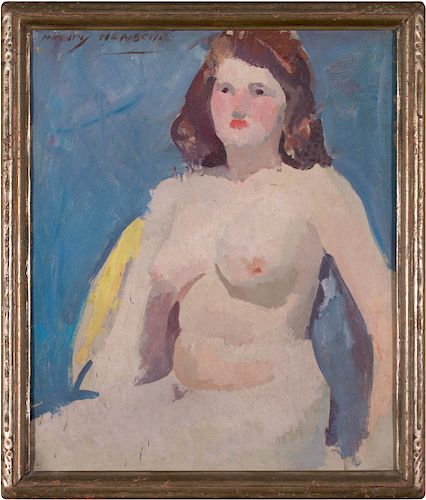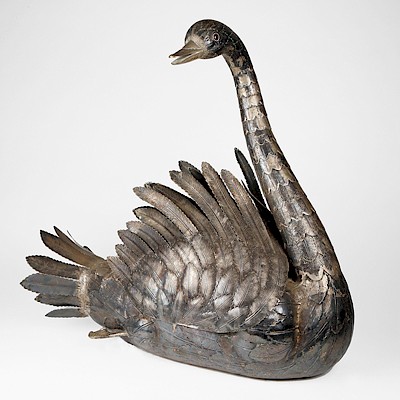Henry Hensche (American, 1899-1992) Seated Nude
About Seller
13010 Larchmere Blvd
Cleveland , OH 44120
United States
Located in the historic art and design district on Larchmere Boulevard in Cleveland, Ohio, WOLFS is a large and diverse art gallery comprised of the main floor, three galleries on the lower level, an upstairs mezzanine, and many works on loan or rotating through storage. Because WOLFS was originally...Read more
Two ways to bid:
- Leave a max absentee bid and the platform will bid on your behalf up to your maximum bid during the live auction.
- Bid live during the auction and your bids will be submitted real-time to the auctioneer.
Bid Increments
| Price | Bid Increment |
|---|---|
| $0 | $10 |
| $100 | $25 |
| $300 | $50 |
| $500 | $100 |
| $2,000 | $250 |
| $5,000 | $500 |
| $10,000 | $10,000 |
| $15,000 | $1,000 |
| $25,000 | $2,000 |
| $50,000 | $5,000 |
| $100,000 | $10,000 |
About Auction
May 12, 2018
Wolfs Gallery info@wolfsgallery.com
- Lot Description
Henry Hensche (American, 1899-1992) Seated Nude Oil on canvas Signed upper left 30 in. h. x 25 in. w., canvas 33 1/2 in. h. x 28 1/2 in. w., as framed HENRY HENSCHE (1899-1992) "We must get rid of the talking painters - those who talk but do not paint, who teach in our art schools, and replace them with practicing painters who have proved by their work that they have something to teach." Born February 25, 1899 in Germany, Henry Hensche came to the United States by way of Antwerp, Belgium. He arrived March 3, 1909 at Ellis Island aboard the British steamship S.S. Kroonland, along with his sister Erna, and his father Fred. He was 10 years old. Henry's mother died before he was two. As a painter and teacher of consumate skill, Hensche is considered by many in the art world to be unparalleled as a fine color visualist in the "art of seeing and painting". He has been called an iconoclast, a pioneer, and the late Grand Central Art Galleries of New York named him, "L'Enfant Terrible of Academie". He is known for teaching his students how to "key" a painting. When Henry Hensche was seventeen, he worked in the stock yards to earn the money that would send him to the Art Institute of Chicago. There he studied with tonalist George Bellows. Hensche later attended the National Academy of Fine Arts, the Art Student's League of New York, the Beaux Arts Institute of Design, and Charles Webster Hawthorne's Cape Cod School of Art. It was there in Provincetown, Massachusetts where Hensche had found his niche and calling. Just as Charles Webster Hawthorne became assistant instructor to William Merritt Chase, Henry Hensche became assistant instructor to Charles Hawthorne. It happened to be right at the time when Hawthorne was intently involved in the study of Claude Monet and his application of color according to different light, such as Monet's series paintings. Hawthorne, nevertheless did not always implement in his commissioned paintings the knowledge he had gained from studying Claude Monet - many of Hawthorne's later works began to show his development in color. The last fifteen years of Hawthorne's life was dedicated to understanding what Claude Monet was doing in practice with the new color pigments. Henry Hensche was instrumental in taking Hawthorne's approach, "mudheads", a step further to the "color block studies", which although simple in shape, are quite effective in developing the painter's basic visual ability. The human eye can not see unless there is light on the subject it is studying. Hensche started students with sun light key, gray day key, north light key, and as one progressed, then to late afternoon light key and early morning light key and finally to the season and time of day. It is the study of the color blocks under different light conditions that give a simple reference yet continually challenge the painter's ability to see the light key and to record it accurately and effectively. Hensche devoted most of his life to this cause of developing a method of study whereby a student painter could grow visually in the understanding of color masses. As his teacher, Charles Hawthorne would say, "beauty in painting comes from putting spots of color together in a beautiful way". After Hawthorne's death in 1930, the mantle had been passed to Henry. Mrs. Hawthorne wanted to sell the name of the Cape Cod School of Art to Henry but he refused. From 1932 to 1935 Henry taught with no name to his school. Then in summer of 1935, he began using the name, The Cape School of Art and taught in the fine Hawthorne tradition. He carried on the intense study of color, each summer until his death December 10, 1992. The schools of Hawthorne and Hensche were only open summers because the winters were too harsh for painting outdoors. In 1974 Hensche began teaching during the winter months at Studio One in Gray, Louisiana. Between 1922 and 1930 he won the Pulitzer Traveling Prize from Columbia University and the Hallgarten Award from the National Academy of Design. He has exhibited at the Art Institute of Chicago, The Corcoran, The Philadelphia Academy of Fine Arts, and many others. Henry Hensche is beloved by all who studied with him and his teachings and influence are evident in the work of the current Cape School style painters including Hilda Neilly, Mary Giammarino, Lois Griffel, Heather Bruce and many others.
- Shipping Info
-
For purchases from the auction, packing and shipping is the responsibility of the buyer. We are happy to consult with successful bidders on the shipment of their purchases and will work with you to ensure successful shipment after the sale. All items will be stored by WOLFS until they are packed by the third party shipper of your choice. Don and Cynthia Czapski have 15 years experience crating and packaging antiques and fragile items and are available for packing purchases from the auction. (216)-561-1740. dczapski@gmail.com Relion Trucking If you are the high bidder on an item that requires trucking from Cleveland to the North East Coast or back and onward to the Chicago area, please contact Relion for additional information and cost. (773) 875-6178 (847) 397-1001 relion@relionservices.com Another alternative nationwide is Craters and Freighters. Renee Dublo 888-272-8311 cleveland@cratersandfreighters.com IF YOU HAVE ANY QUESTIONS WHATSOEVER ON PACKING, SHIPPING AND WHAT HAPPENS AFTER THE SALE PLEASE CONTACT US AT 216.721.6945 or info@wolfsgallery.com
-
- Buyer's Premium



 EUR
EUR CAD
CAD AUD
AUD GBP
GBP MXN
MXN HKD
HKD CNY
CNY MYR
MYR SEK
SEK SGD
SGD CHF
CHF THB
THB







